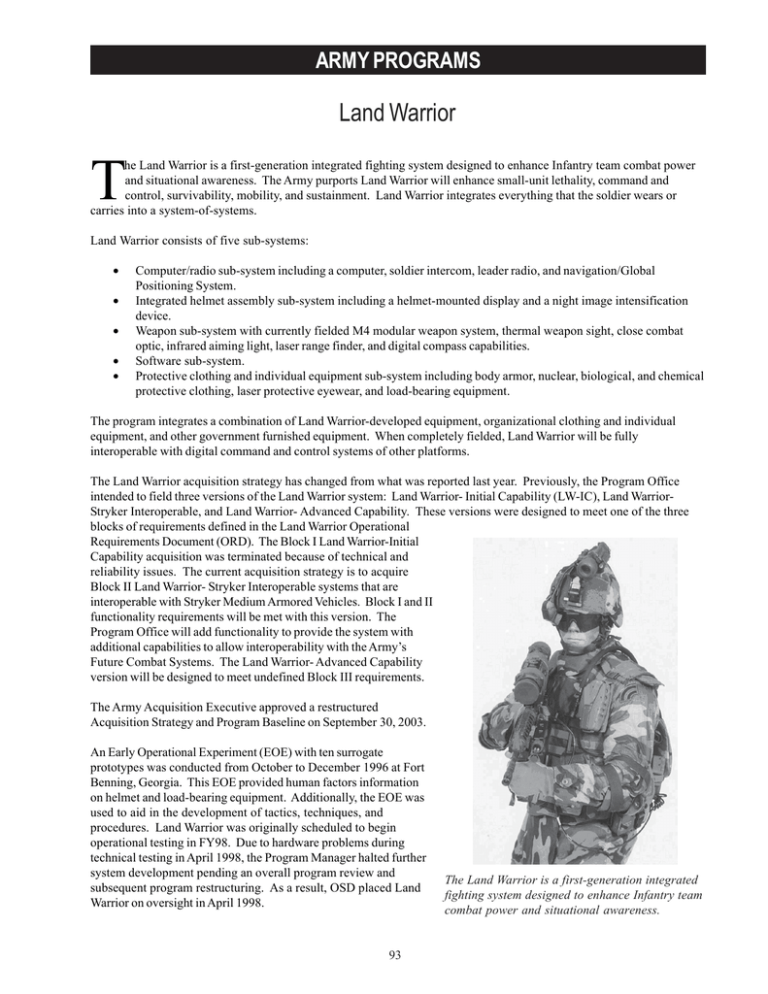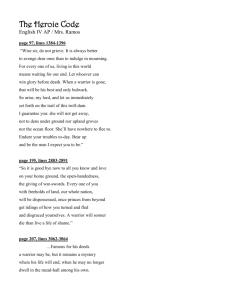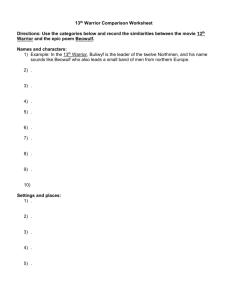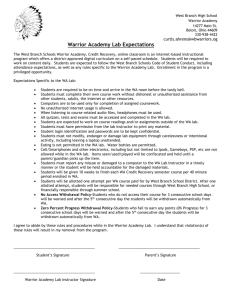T Land Warrior ARMY PROGRAMS
advertisement

ARMY PROGRAMS Land Warrior T he Land Warrior is a first-generation integrated fighting system designed to enhance Infantry team combat power and situational awareness. The Army purports Land Warrior will enhance small-unit lethality, command and control, survivability, mobility, and sustainment. Land Warrior integrates everything that the soldier wears or carries into a system-of-systems. Land Warrior consists of five sub-systems: • • • • • Computer/radio sub-system including a computer, soldier intercom, leader radio, and navigation/Global Positioning System. Integrated helmet assembly sub-system including a helmet-mounted display and a night image intensification device. Weapon sub-system with currently fielded M4 modular weapon system, thermal weapon sight, close combat optic, infrared aiming light, laser range finder, and digital compass capabilities. Software sub-system. Protective clothing and individual equipment sub-system including body armor, nuclear, biological, and chemical protective clothing, laser protective eyewear, and load-bearing equipment. The program integrates a combination of Land Warrior-developed equipment, organizational clothing and individual equipment, and other government furnished equipment. When completely fielded, Land Warrior will be fully interoperable with digital command and control systems of other platforms. The Land Warrior acquisition strategy has changed from what was reported last year. Previously, the Program Office intended to field three versions of the Land Warrior system: Land Warrior- Initial Capability (LW-IC), Land WarriorStryker Interoperable, and Land Warrior- Advanced Capability. These versions were designed to meet one of the three blocks of requirements defined in the Land Warrior Operational Requirements Document (ORD). The Block I Land Warrior-Initial Capability acquisition was terminated because of technical and reliability issues. The current acquisition strategy is to acquire Block II Land Warrior- Stryker Interoperable systems that are interoperable with Stryker Medium Armored Vehicles. Block I and II functionality requirements will be met with this version. The Program Office will add functionality to provide the system with additional capabilities to allow interoperability with the Army’s Future Combat Systems. The Land Warrior- Advanced Capability version will be designed to meet undefined Block III requirements. The Army Acquisition Executive approved a restructured Acquisition Strategy and Program Baseline on September 30, 2003. An Early Operational Experiment (EOE) with ten surrogate prototypes was conducted from October to December 1996 at Fort Benning, Georgia. This EOE provided human factors information on helmet and load-bearing equipment. Additionally, the EOE was used to aid in the development of tactics, techniques, and procedures. Land Warrior was originally scheduled to begin operational testing in FY98. Due to hardware problems during technical testing in April 1998, the Program Manager halted further system development pending an overall program review and subsequent program restructuring. As a result, OSD placed Land Warrior on oversight in April 1998. 93 The Land Warrior is a first-generation integrated fighting system designed to enhance Infantry team combat power and situational awareness. ARMY PROGRAMS TEST & EVALUATION ACTIVITY There have been no operational tests to date. Land Warrior participated in the Joint Contingency Force Advance Warfighting Experiment (JCF AWE) conducted at the Joint Readiness Training Center, Fort Polk, Louisiana, in September 2000. During the JCF AWE, a platoon from the 82nd Airborne Division, equipped with prototype Land Warrior systems, demonstrated the potential of Land Warrior to enhance tactical movement, survivability, and situational awareness. Combined contractor and developmental testing for the restructured program began in August 2002 and demonstrated the presence of LW-IC functionally while also establishing a program reliability baseline. LW-IC met developmental testing criteria in September 2002. Government testing during November 2002 indicated that the LW-IC reliability was low. An early functional assessment by U.S. Army Rangers during February 2003 concluded that the LW-IC systems were not reliable. The Program Manager halted developmental testing in March 2003. The Land Warrior Test and Evaluation Master Plan (TEMP) was approved at the Army level in October 2003 and forwarded to OSD. The revised Land Warrior TEMP that reflects the restructured acquisition strategy is under review. The Program Manager has scheduled the initial operational test for FY06. TEST & EVALUATION ASSESSMENT The LW-IC effort was canceled because of low reliability in developmental testing. Two Limited User Tests will be conducted prior to the IOT&E in order to reduce the risk of previous reliability and power problems associated with the program. In addition, Land Warrior and Future Combat Systems integration will likely be a challenge in any future operational test events linking the two systems. 94




